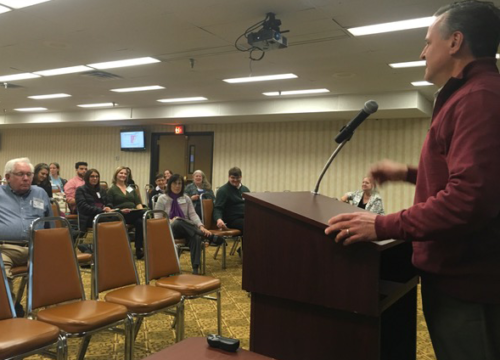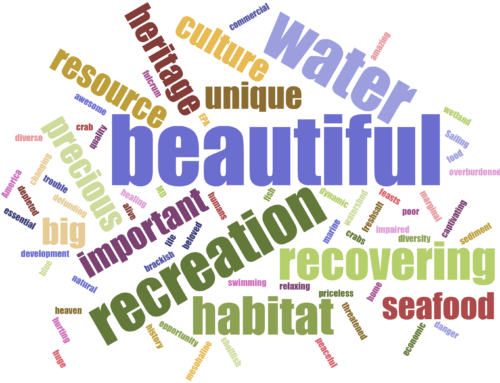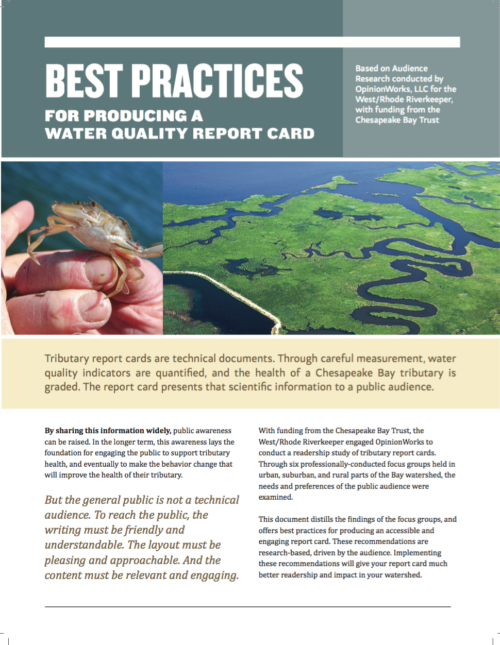Talk Less, Show More: Communicating Challenges and Successes in a Changing World
Bill Dennison ·At the request of Kathy Stecker from the Maryland Department of Environment, Steve Raabe from Opinion Works and I partnered in a session at the annual Maryland Water Monitoring Council meeting held at the Maritime Conference Center in Linthicum, MD. We called our session “Communicating Challenges and Successes in a Changing World.” The Integration and Application Network has collaborated with Steve Raabe and Opinion Works for many years, so this partnership was a natural fit. Steve and I ran an interactive session so that attendees could actively participate.

Steve provided a short primer on diffusion theory for communication and some recent data on citizen stewardship for Chesapeake Bay. The survey demonstrated that clean water is a high priority for people in the Chesapeake region, an encouraging result. A large majority of people were convinced that by working together, water pollution can be fixed, but a minority of people felt that their actions contribute to water pollution. Clearly, we need to work to develop a better environmental literacy so that people better understand their role and contributions to water pollution. I was especially pleased to see that “good news” about restoration progress encourages people to do MORE, not less, in terms of restoration efforts.
One of the interactive exercises was that I had everyone write three words to describe Chesapeake Bay, and Suzi Spitzer helped formulate a word cloud based on their responses. The key words “beautiful,” “recovering,” and “recreation,” were used to emphasize the iconic nature of the Bay and the growing perception of its improving health. This message of recovery has been promoted by our recent Chesapeake Bay report card releases.

We also had attendees generate an “. . . and . . . but . . . therefore . . .” (ABT) statement to practice developing strong narratives associated with messages to community groups. We were impressed at the quality of the ABT statements. Steve judged which ones were the best, and the winners received some IAN swag.

Steve summarized the report entitled “Best Practices for Producing a Water Quality Report Card” that Opinion Works generated in partnership with IAN. The report used focus groups and found that it was important for report cards to present clear and visual grades, link actions to indicators (but only one action, not a shopping list), present a warm, inviting and inspirational tone, use common language, and have a clean, uncluttered appearance. This was very useful feedback for IAN as well as the citizen science groups that are producing regional report cards.
I wrapped up the session with a short poem that I wrote about communicating science. It was inspired by a song in the Lin Manuel Miranda musical “Hamilton.” The song is “Aaron Burr, Sir” in which Burr is giving young Alexander Hamilton advice to “Talk less, smile more.” My version is “Talk less, show more:”
Talk Less, Show More
8 Dec 2017
William C. Dennison
Talk less, show more
Let them know what you are doing and why
You only have one shot
To engage people and catch their eye.
Tell stories, use facts
Employ the rubric of and, but, therefore
Make it real, make it fun
And you can begin to build audience rapport.
Complex data, clean graphics
Avoid death by PowerPoint
Create compelling graphics
Banish the dreaded bullet point.
Eye contact, time conscious
Don’t just read your talk
Look at your audience
And keep an eye on the clock.
Invest wisely, practice often
Try your talk out with everyone
So your communication investment
Will pay off in the long run.
About the author
Bill Dennison

Dr. Bill Dennison is a Professor of Marine Science and Vice President for Science Application at the University of Maryland Center for Environmental Science.

